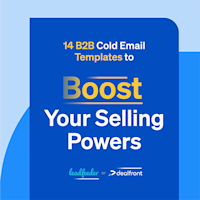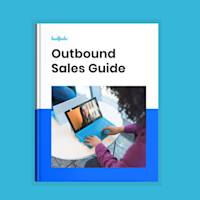It’s official, outbound sales are now elbowed “out” of the spotlight.
Shiny inbound sales strategies and tactics have stolen the stage. But are they rendering outbound sales strategies redundant?
Not at all.
Celebrated for its ability to boost brand awareness and generate passive leads, the inbound sales process is crowned king.
But using it to attract leads has snowballed into a complex process.
You’re now up against waves of content, diminishing search traffic, and forever-evolving search algorithms that strong-arm you into pleasing the Google gods for traffic and leads.
Inbound sales tactics still work; they just take more work to work than before.
If you need an influx of leads urgently, want more control over the leads you receive, or don’t have the budget (or appetite) for inbound practices, outbound sales are your solution — and with that, you'll likely want an outbound sales software.
If you have questions like:
- Is outbound sales and outbound lead generation effective?
- How do I generate leads with outbound sales?
- What is the difference between outbound and inbound sales?
- How to optimize the outbound sales process for maximum ROI?
I’ve created this outbound sales guide just for you.
Note: Starting an outbound sales campaign? Try Leadfeeder free for 14 days to see which companies visit your website, the pages they visit, whether or not they’re in your CRM, and more.
What is outbound sales?
Outbound sales is the process of reaching out to a fitting potential customer to pitch your solution to their assumed problem.
Bridge US is a B2B immigration software/service solution for individuals and businesses. They were facing a relatively empty calendar in 2017.
In a bid to drive more sales, Bridge US teamed up with B2B marketing agency Revenuezen.
After training sales reps with 1-on-1 coaching, solidifying their sales process, and upgrading their CRM, the results are pretty inspiring:
An extra 791k in the pipeline, per month.
Improved response and email open rates.
Over 400 new qualified appointments set
A successful outbound sales strategy can aggressively increase revenue. But only when done right and when using the right outbound sales software.
I recently launched our outbound sales team, and we’re making great progress with outbound lead generation.
The team has managed to more than double new trial sign-ups in less than five months.
Seen as the traditional sales strategy, common examples of outbound sales include:
Cold emails
Door-to-door visits
Trade shows and industry events
The channel and approach will vary, but the outbound sales process is the same:
Leads don’t stumble upon and find you. Instead, you reach out to and qualify leads to close, from scratch.
The difference between inbound and outbound sales
You can sum up the defining features and differences between outbound sales and inbound sales in two words: push and pull.
With outbound sales, you’re pushing or communicating your brand, your message, and your product/service directly or into the periphery of customers.
For instance, at Leadfeeder, I’ve created an outbound sales team that will find and email users not already using our outbound sales software.
Inbound sales, on the other hand, refer to pulling, or attracting leads via content marketing, SEO, viral content campaigns, and social media.
At Leadfeeder, our inbound sales team contacts you after you’ve signed up for a free trial.
Leads find you, rather than you searching for them.
Inbound vs. outbound sales, which is better?
Let’s imagine you’re a marketing/web design agency.
Let’s also imagine that your leads are actively looking for content on how to “improve brand strength through web design.”
Out of the two scenarios below, which is more likely to result in a lead buying from you?
Painstakingly publishing numerous guides and downloadable marketing checklists and ebooks (like everyone else) for “branding through web design”. Hoping they enter your sales funnel instead of your competitor’s – they’ll probably enter both.
Delivering a fresh cold email with valuable tips while they’re in the middle of researching “how to strengthen branding through web design” into their inbox, like this:
Hi [First Name],
I noticed you visited our website today and checked out the article on web design and branding. I noticed the following things about your company and how you can strengthen your brand through web design:
- Tip:1 - Tip:2 - Tip:3
At [name of web design/marketing company,]
We specialize in “done for you” branding and web design packages. Are you free next week for a quick 10-15 minute call to see if we can help you?
The outbound cold email is the clear winner here, and research agrees:
During the early exploration stage of the buying cycle, 71 percent of B2B buyers admit to accepting a contact request with a new potential provider.
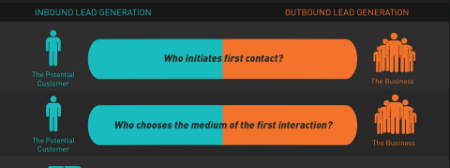
So it’s not a case of inbound versus outbound sales.
Your current sales approach depends on your business, your goals, your budget, your market, and a whole bunch of other factors.
Even when B2B leads visit your website, 98 percent of website visitors often fail to leave contact information and become approachable leads.
At Leadfeeder, we actually use our own outbound sales software to find out who these curious companies and visitors are to fill our pipeline with “warm” leads.
The advantages of outbound sales over inbound
A big advantage of outbound sales over inbound sales is that it empowers sales reps to directly target leads and close deals with decision-makers.
Other advantages over inbound include quicker response times from leads.
This shortens the sales cycle and is a cost-effective way of generating sales when compared to lengthy, expensive inbound sales practices like content marketing.
By focusing on a single aspect of the lead gen spectrum—inbound, you’re leaving sales on the table.
But if you have to pick between the two, the advantages of outbound sales over inbound are listed below to help you decide.
Get quick feedback
Outbound sales tactics have a faster feedback cycle.
Unlike inbound sales, you’re not waiting for leads to discover, trust and like, then take action and approach you.
Sure, following up is an expected and necessary part of the process. But when you present a demo or ask for a sale, you’re often greeted with a yes-or-no answer.
This real-time feedback lets you build upon and evolve each future call, email, and pitch you send.
Target decision-makers directly
Content marketing, social media, and email marketing have become rote practices.
There’s an ocean of content for leads to consume but their business is usually won by a single service/product provider.
B2B companies have multiple decision-makers, higher-priced products, and longer buying cycles.

This is where outbound lead generation has a distinct advantage to cut through the noise. It makes reaching decision-makers and catching them during their critical research phase possible.
Validate new ideas and test new territory
If you’re venturing into new territory, you can validate a new idea or product relatively quickly.
Why wait months for feedback when you can test the waters with outbound sales – minus the long response time and hefty content generation or PPC costs?
Generate leads, while spending less time and money
Hiring professionals to write content, produce polished videos, or present webinars is neither cheap nor quick.
It takes months, years even, for some to see results.
Outbound lead generation travels through the sales cycle quicker. You set the pace, shortening your time to sale, which – if you are a startup, need to bolster your cash flow, or need sales like yesterday – is a big deal.
What is the outbound sales process?
The outbound sales process is a series of steps taken by a sales team/individual to turn a lead into a paying, or “closed” customer.
A strong outbound sales process allows you to repeatedly close deals by giving reps a proven framework to follow.
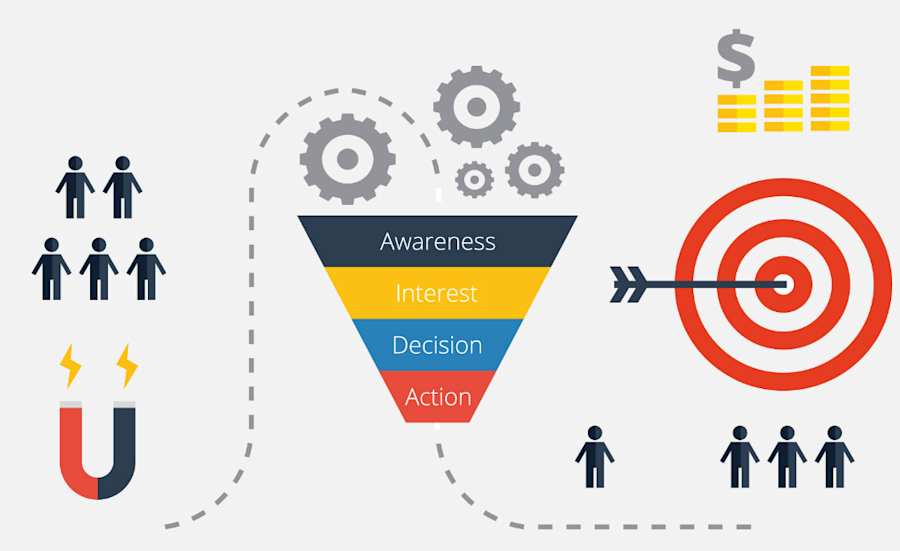
The channels, tools, and tactics used are your sales muscles.
Each outbound sales software your team masters, each tactic they experiment with, and each demo they present, is a rep (pun unintended); you’ll develop a stronger overall process performing these reps overtime.
But the skeletal frame that determines the ultimate strength of your outbound lead generation?
It remains the same. Here’s what it looks like:
Step 1: Identifying leads
Who are you selling to?
What problems are they facing that make them prospects?
How can you help them?
Simple questions? Sure they are.
But depending on the product you offer and verticals served, answers can be complex and nuanced; echoing further along the outbound sales process.
Influencing your sales team’s ability, the tone you use, and how you approach and close leads.
Step 2: Generating leads or prospecting
Outbound lead generation is all about filling up your pipeline with the contact details of prospects.
Whether it’s:
Using outbound sales software like a website visitor identification tool
Generating leads manually – usually via a sales rep crawling the web or attending conferences and events to harvest emails, names, and connect with decision-makers.
Outsourcing to a third-party company that handles lead generation for you.
Buying a leads database that meets the basic definition of your “target market”. This usually results in lower response and conversion rates.
A list of people for your team to contact is the result.
Need help with lead generation?
We’ve got 61 B2B lead generation strategies and tactics just for you.
Step 3: Qualifying leads through outreach
The third step is where things get real. Reps begin contacting leads via cold email, cold calls, or if they’re really brave, face-to-face contact.
They also have the chance to qualify leads into hot (ready to buy), warm (interested), and cold (unlikely to buy) so they can adapt future follow-ups and approaches.
Step 4: Sales call
Sales reps now get to do what they do best, sell. This is often the first live contact reps have with a responsive lead. It could be a meeting with a board of directors, a software demonstration, or a longer chat over the phone.
Step 5: Closing the deal
Congratulations! The sales calls and meetings were successful. Your sales reps have turned a lead into a paying customer. The outbound sales cycle ends, and the onboarding process begins.
Now let’s look at how to maximize ROI in each stage.
Power up your outbound sales process with these 5 tips
Outbound sales booster 1: Use deep market knowledge to harvest high converting leads
There’s a reason why Okdork spent $3 million testing Facebook ads, and why Hollywood has spent over $80 million on market research.
It pays to know your market.
To develop a deep familiarity with your market, equip your reps with compelling buyer personas before they hunt for leads. Another recommendation here is to arm your team with a solid sales tech stack.
This information will prove invaluable throughout the outbound sales process. You’ll arm sales rep with confidence, attract better leads, and boost closing rates.
Outbound sales booster 2: Improve lead generation with easily-accessible data to personalize outreach
42 percent of B2B marketing professionals state that a lack of quality data is their biggest barrier to lead generation.
There’s a powerful source of data that most reps have access to, but don’t capitalize on – previous customers.
Scheduling follows up phone calls and emails is an overlooked treasure trove of feedback and data (that can even influence future purchases) you can use to personalize future outreach.
Shane Snow’s 1000 cold emails to high-level executives — all from fortune 500 and Inc 500 companies—aimed to test the variables that influence cold outreach.
In the experiment, he tweaked multiple outreach variables like:
Subject lines (vague vs specific)
Length (short vs long emails)
Purpose (focusing on the impact leads would have, vs focusing on how receiving a response from them would help him)
Request (asking for their knowledge vs asking for them to take action)
Shane’s team stumbled across some interesting finds. For example, compared to specific “explanatory” subject lines, curiosity-piquing subject lines resulted in higher response and reply rates from cold leads.
But, after the 1000-email campaign ended, his number one conclusion was:
“Tactics for optimizing sales emails are well and good, but they’re not as important as personalized research and sender/sendee fit,” he also added that “the little things you can do to optimize cold email is all moot without one thing–personalization.”
Use the questions below to give you insight on how to personalize your outreach:
What made you choose us over the competition?
You might assume it’s based on price. But after speaking to paying customers, you realize your UI and onboarding process simply made you the better option.
Would you refer us to others?
What makes them say yes or no will reveal how they view your product/service based on the pros/cons.
What are your short-term goals? Long-term goals? How has our product/service influenced them?
You get to hear exactly how you have improved their daily, monthly, or yearly operation.
Answers to the above can be used to optimize lead generation.
Imagine if your sales reps knew the exact places your customers hang out, where they get information from, and what motivates them to buy.
Wouldn’t that make a world of difference to the quality of leads you get?
Outbound sales booster 3: Break away from competitors with a killer unique selling proposition
In the early 1900s legendary copywriter, Claude Hopkins launched Schlitz beer from 8th rank in sales to no.1.
At the time, beer companies boasted about the purity of their beers.
So Hopkins did something unique that would make copywriting history. In the ad that took Schlitz to the top, Hopkins described in detail how Schiltz beer was pure.
(All the beer companies followed the same purifying process at the time, but the Schlitz ad was the first to convey this to consumers.)
He described how the beer was cooled in a special way that removed impurities.
How every pipe was cleaned twice for purity, and how each bottle was sterilized four times before being trusted to hold Schlitz beer.
He even wrote about the 4,000-foot well that supplied the water, despite the Lake Michigan nearby being an acceptable source.
Compare the above to saying “our beers are purer than the other guys”…
And Schiltz is the undeniable winner. And that’s the power of a killer USP.
Want to win more sales and be remembered when engaging with decision-makers?
Nail down your USP.
It separates you from the competition and imbues your team with confidence.
Make sure your reps internalize it and can articulate it without hesitation.
Outbound sales booster 4: Seal the deal with solid benefits, not fuzzy features
Getting your foot in the door with a sales meeting is great. Unfortunately, it doesn’t translate to an instant sale.
Reps still have to you know…sell.
To ensure sales reps actually close the deal, stress the importance of sympathizing and listening to leads, then responding based on what they learn with benefit-driven points.
Apple’s iPod ad is a great example:
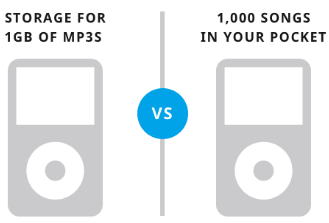
The feature is “1GB of storage for MP3s”, the benefit to the user is “1000 songs in your pocket”.
The feature of this post you’re reading is “you’ll learn about the outbound sales process”, the benefit is “you’ll be able to use the outbound sales process to get more leads, increase sales and make more profit.’‘
The “benefit-driven” mindset prevents reps from blindly reciting features and sounding like a human radio ad—encourage it when they’re going out to close.
Outbound sales booster 5: Create a team of hungry closers
Ever tried to exercise at some point in your life?
Motivation to train can dwindle rapidly. This is why people like to partner up and train with a friend.
Research confirms when doing a task that requires a lot of motivation to start – like exercising or cold calling/emailing leads – having a partner, even a virtual one, enhances performance and motivation.
It is called the Kohler Effect – where people work harder as part of a group when compared to working alone.
Want to form a hustle-hungry sales team?
Sprinkling in glamorous gifts, generous commissions, and better compensation – the usual stuff – works.
But you can amplify the peer-based Kohler Effect by gamifying the sales process.
There’s a strong case for gamification.
71 percent of companies that used it saw an 11-50 percent boost in sales rep performance. Add some gamification into your outbound sales process by:
-Measuring the right metrics. Working backward from your sales goals, define which metrics you want to track. Calls made? Sales demos booked? Time spent pitching leads? Use your CRM to strike a balance between revenue-driving activities and actions that are under a rep’s control. In some cases, the process might look more like outbound lead generation than closing outbound sales right away depending on the product and market.
-Adding monthly and weekly contests. This will encourage healthy competition, reinforcing the “hustle harder” ethos you want to create.
-Give positive feedback and recognition. When they don’t feel recognized and appreciated, employees are twice as likely to underperform and quit. Acknowledge extra effort, praise good performance, and show trust by giving more responsibility.
These steps encourage a culture of hardworking, self-motivated sales reps who want to win you more sales and derive satisfaction from good performance.
Outsell complacent competitors with an outstanding outbound B2B sales process
The outbound sales process can be complex and tricky to get right, but it’s worth it.
Because after bleeding time, money, and content to please the Google gods, your competitors still patiently wait for the king - inbound sales - to “hum and haw” about bestowing B2B leads their way.
Why wait?
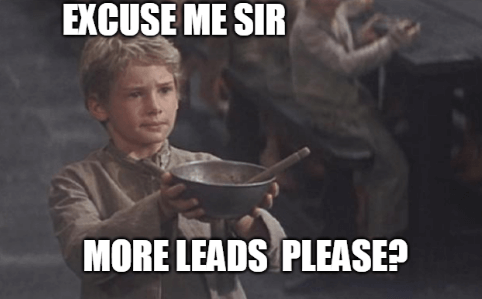
Why not rally your royal sales reps and outsell your competitors?
With a proven system to attract quality leads, boost response rates and close more sales, you can.
Note: Starting an outbound sales campaign? Try Leadfeeder free for 14 days to see which companies visit your website, the pages they visit, whether or not they’re in your CRM, and more.
Now that you're here
Leadfeeder is a tool that shows you companies that visit your website. Leadfeeder generates new leads, offers insight on your customers and can help you increase your marketing ROI.
If you liked this blog post, you'll probably love Leadfeeder, too.
Sign up